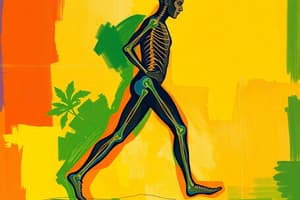Podcast
Questions and Answers
Most movement occurs in the ______ plane, involving flexion and extension.
Most movement occurs in the ______ plane, involving flexion and extension.
sagittal
During the gait cycle, the ______ phase precedes the initial contact phase.
During the gait cycle, the ______ phase precedes the initial contact phase.
loading
The stance phase begins when the left toe has left the ______.
The stance phase begins when the left toe has left the ______.
ground
The moment the right heel makes contact with the ground is referred to as ______.
The moment the right heel makes contact with the ground is referred to as ______.
The purpose of the single-support phase is to allow the body's center of mass to travel over the ______ foot.
The purpose of the single-support phase is to allow the body's center of mass to travel over the ______ foot.
Toe Off and heel rise occur during the ______ phase of the gait cycle.
Toe Off and heel rise occur during the ______ phase of the gait cycle.
The double support phase involves both feet in contact with the ______.
The double support phase involves both feet in contact with the ______.
In the loading phase, the front leg absorbs energy from ______ and becomes steady.
In the loading phase, the front leg absorbs energy from ______ and becomes steady.
COM moves forward to front of foot → heel ______
COM moves forward to front of foot → heel ______
The purpose of the pre-swing phase is to get ready for the ______ phase.
The purpose of the pre-swing phase is to get ready for the ______ phase.
In the deceleration phase, the body is preparing to set the foot ______.
In the deceleration phase, the body is preparing to set the foot ______.
The overall swing phase constitutes ______% of the gait cycle.
The overall swing phase constitutes ______% of the gait cycle.
Minimum foot clearance (MFC) is important to avoid ______ during gait.
Minimum foot clearance (MFC) is important to avoid ______ during gait.
The acceleration phase involves hip pendulum motion and putting all ______ weight from the left limb into the right limb.
The acceleration phase involves hip pendulum motion and putting all ______ weight from the left limb into the right limb.
Each phase of the gait cycle lasts ______% of the overall cycle.
Each phase of the gait cycle lasts ______% of the overall cycle.
Toe Off (TO) marks the moment the right foot is ______ from the ground.
Toe Off (TO) marks the moment the right foot is ______ from the ground.
Flashcards
Gait Cycle Phases
Gait Cycle Phases
The distinct steps of walking, including stance and swing phases.
Stance Phase
Stance Phase
The portion of the gait cycle when the foot is in contact with the ground.
Swing Phase
Swing Phase
The portion of the gait cycle when the foot is not in contact with the ground. The foot is moving forward.
Loading Response
Loading Response
Signup and view all the flashcards
Mid-stance Phase
Mid-stance Phase
Signup and view all the flashcards
Double Support
Double Support
Signup and view all the flashcards
Single Support
Single Support
Signup and view all the flashcards
Gait Cycle Percentage
Gait Cycle Percentage
Signup and view all the flashcards
Terminal Stance Phase
Terminal Stance Phase
Signup and view all the flashcards
Initial Contact
Initial Contact
Signup and view all the flashcards
Pre-swing Phase
Pre-swing Phase
Signup and view all the flashcards
Step Width
Step Width
Signup and view all the flashcards
Gait Cycle
Gait Cycle
Signup and view all the flashcards
Base of Support (BOS)
Base of Support (BOS)
Signup and view all the flashcards
Center of Mass (COM)
Center of Mass (COM)
Signup and view all the flashcards
Study Notes
Gait Analysis Overview
- Gait is a multi-layered story, involving many body segments and planes.
- Most movement occurs in the sagittal plane, focusing on flexion and extension.
- Understanding gait terminology is crucial for further analysis.
- Gait analysis provides a foundation for future video assignments.
Introduction to Gait Analysis
- Repeated falling with intention (as a learning tool).
- Swing and stance phases (40% and 60%, respectively).
- Phases of double and single limb support are assessed.
- Identify events defining distinct phases (e.g., loading, mid-stance, terminal stance, pre-swing etc.).
Gait Cycle Phases (Right Foot)
- Loading (LOAD): Initial Contact (IC), Opposite Toe Off (OTO). Stance begins when right heel contacts the ground.
- Mid-stance (MST): Takes up 40% of the gait cycle. Left toe off, right heel rise (HR).
- Terminal Stance (TST): Opposite Initial Contact (OIC), Toe Off (TO). Right toe off, left foot makes initial contact.
- Pre-swing (PSW): Initiate preparation for swing by loading the left limb.
Loading Phase Details
- Movement transitions from a double support phase to single support phase.
- Rear leg transfers weight to the front leg during the initial contact.
- This phase focuses on absorbing impact from the step/swing, steadily preparing to support the body weight.
Mid-stance Phase Details
- The opposite leg is not touching the ground during this single support phase.
- The center of mass (COM) travels forward (anterior) over the fixed support foot.
Terminal Stance Phase Details
- The center of mass (COM) moves forward beyond the forefoot leading into opposite initial contact.
- The phase leads into the opposite leg engaging in the gait cycle.
Pre-swing Phase Details
- The phase is preparation for the swing phase.
- The body loads up the left limb, unloads the right limb, and transfers weight to get ready to lift the right foot off the ground.
Swing Phase Details
- The primary objective is to advance the limb forward to complete the gait cycle.
- Movement resembles a pendulum, facilitating hip joint flexion followed by knee joint extension.
- Minimum foot clearance (MFC) is a critical parameter in this phase.
Acceleration and Early Swing (ESW)
- (Early swing) is characterized by toe off and foot adjacent phases.
- Acceleration phase is characterized by great hip pendulum motion.
Mid-Swing (MSW)
- Right foot/limb is in a similar anterior-posterior position as the opposite limb.
- The foot reaches peak anterior velocity.
- The knee extends with a gradual acceleration.
Terminal Swing (TSW)
- Deceleration phase of swing.
- The body prepares to contact the ground.
- Weight bearing is transferred from the swinging/left limb to the right limb.
Temporal-Spatial Parameters (TSP)
- Walking base: The width of the base of support between the heels.
- Step Length: Distance covered by one foot in a cycle.
- Stride Length: Combined distance covered by both feet during a cycle.
Wrapping Up Gait Analysis
- Calculate gait speed (m/s).
- Assess cadence (steps/minute).
- Determine the step length (m).
- Convert cadence to steps per second.
- Calculate comfortable walking speeds for adults (e.g., 1.2-1.4 m/s).
Studying That Suits You
Use AI to generate personalized quizzes and flashcards to suit your learning preferences.




